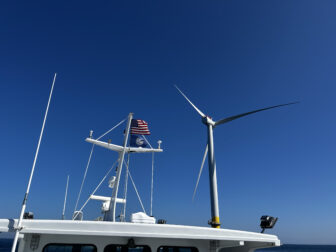The Nation
By Mike Tidwell
The presidential candidates decided not to speak about climate change. But climate change has decided to speak to them. And what does a thousand-mile-wide storm pushing 11 feet of water toward our biggest population center want to say just days before the election? It is this: We are all from New Orleans now along the U.S. east coast. Climate change – through measurable sea-level rise and a documented increase in the intensity of Atlantic storms – has now made 100 million Americans virtually as vulnerable to catastrophic impacts as the victims of Katrina seven years ago.
 The rather prophetic cover of Mike Tidwell’s 2006 book predicting the Hurricane Sandy strike on New York City. The New York Academy Sciences has already begun examining the viability of three massive floodgates near the mouth of New York Harbor, not unlike the Thames River floodgate that protects London today. Another floodgate has been proposed for the Potomac River just south of Washington, fending against the tsunami-like surge tide of future mega storms. Plus there will be levees. Everywhere. Imagine the National Mall, Reagan National Airport and the Virginia suburbs well below sea level, at the mercy of “trust-us-they’ll-hold” levees maintained by the Army Corps of Engineers.
The rather prophetic cover of Mike Tidwell’s 2006 book predicting the Hurricane Sandy strike on New York City. The New York Academy Sciences has already begun examining the viability of three massive floodgates near the mouth of New York Harbor, not unlike the Thames River floodgate that protects London today. Another floodgate has been proposed for the Potomac River just south of Washington, fending against the tsunami-like surge tide of future mega storms. Plus there will be levees. Everywhere. Imagine the National Mall, Reagan National Airport and the Virginia suburbs well below sea level, at the mercy of “trust-us-they’ll-hold” levees maintained by the Army Corps of Engineers.
Hurricane Sandy is just now giving a glimpse of this global warming future. Oceans worldwide are projected to rise as much as three more feet this century, and much higher if the Greenland ice sheet melts away. And intense storms are already becoming much more common. These two factors together will in essence export the plight of New Orleans, bringing the Big Easy “bowl” effect here to New York City and Washington, as well as to Charleston, S.C., Miami, New York and other coastal cities. Assuming we want to keep living in these cities, we’ll have to build dikes and learn to exist beneath the surface of surrounding tidal bays, rivers and open seas — just like New Orleans.
Meanwhile, it’s not our imagination that hurricanes have grown more ferocious than in the past. Multiple scientific studies in the past few years have found that rising sea-surface temperatures linked to global warming are causing an increase in the number of stronger hurricanes. Sandy, right now, is approaching the east coast atop Atlantic sea-surface temperatures a full five degrees Fahrenheit above normal. One study by the Massachusetts Institute of Technology concluded that hurricane wind speeds have doubled in the past 30 years. This may account for the fact that among the six most powerful hurricanes recorded in the Atlantic Basin — going back 150 years — three occurred over 52 days in 2005: Katrina, Rita and Wilma. And Sandy, as measured by its area of influence, is now the biggest storm ever recorded in the Atlantic.
Higher sea levels create other conditions that will only enhance hurricanes. In 1985, Hurricane Gloria made landfall north of New York Harbor. As a Category 2 storm, it could have had a serious surge tide. But it was a relative dud, causing only minor flooding. New York got lucky because the storm struck at maximum low tide. But with three feet of sea-level rise, we will be creating what amounts to permanent high-tide conditions in the New York region and everywhere else, guaranteeing that future storms like Sandy will become surge-tide heavyweights.
What can we do? Three major options: 1) abandon our coastal cities and retreat inland, 2) stay put and try to adapt to the menacing new conditions, or 3) stop burning planet-warming fossil fuels as fast as possible.
Retreat, of course, is no one’s first choice. But adapting means committing fully to the New Orleans model. It means potentially thousands of miles of levees and floodwalls across much of the east coast. And that’s just to handle the rising sea. For hurricane surge tides, the only solution might be to build those major floodgates across New York Harbor, the Potomac Rivers and elsewhere. But are we truly ready to become New Orleanians, casting our lot behind ever-higher, unsustainable walls? Once we commit to fortified levees and massive floodgates, there’s no turning back. It’s an all-or-nothing proposition, as New Orleans has graphically demonstrated.
In truth, we must combine some level of adaptation with the third option: switching away from fossil fuels and onto clean energy. Clean energy is less expensive, less risky and overall much better for us. It’s the option that treats the disease of global warming, not just the symptoms. Only by dramatically reducing greenhouse gas pollution – by putting a price on carbon fuels and ushering in real gains in wind and solar power and efficiency — can we slow the sea-level rise and potentially calm the growth in hurricane intensity.
Perhaps now, after seeing the full wrath of Sandy, the next president will move from total silence to real action.
*****
Additional Resource: Listen to a 11/2 phone briefing with Mike Tidwell and MD scientists Dr. Court Stevenson and Dr. William Boicourt. They discuss Hurricane Sandy, climate change and the threat to the Chesapeake Region. (Hit the play button to listen now, or right-click and select “save as” to download the audio file.) Note: Due to technical difficulties, the recording begins a few minutes in to the briefing, with Tidwell speaking.





